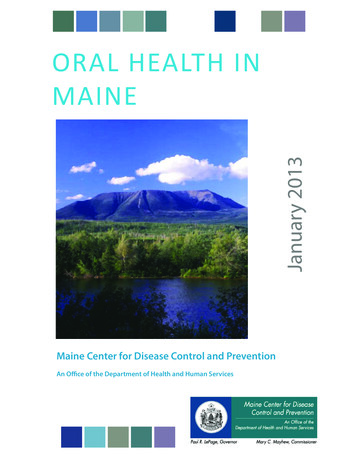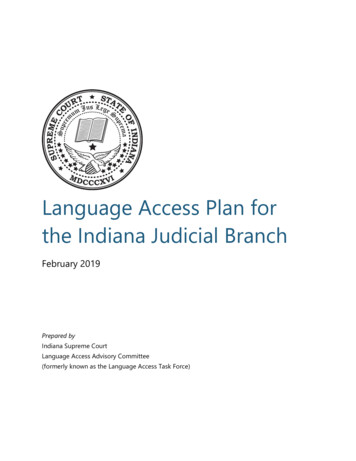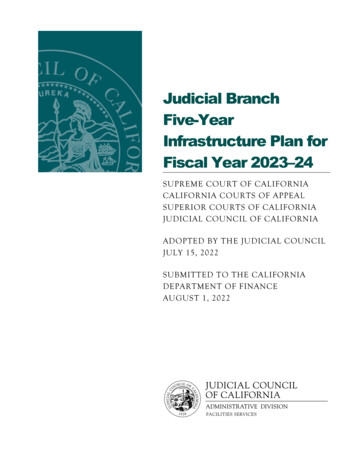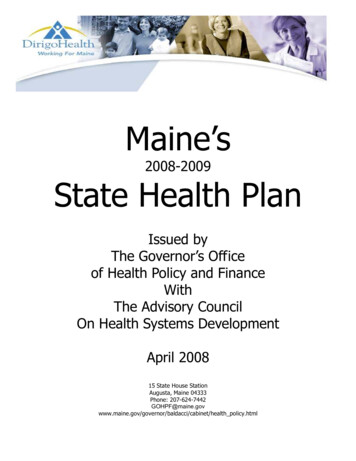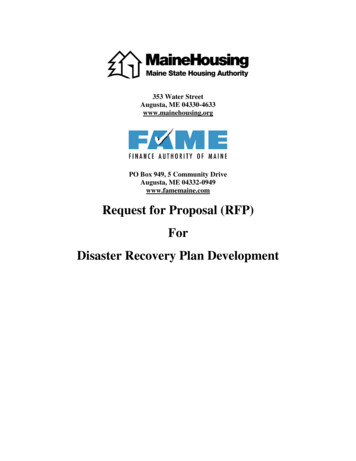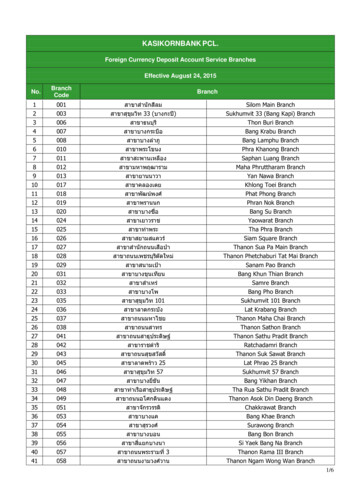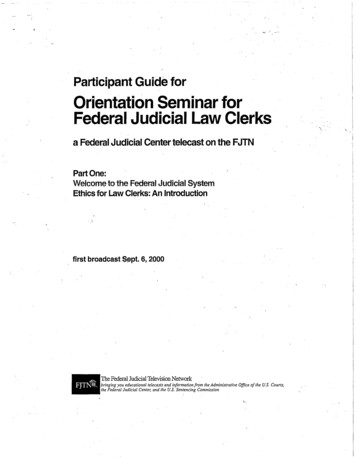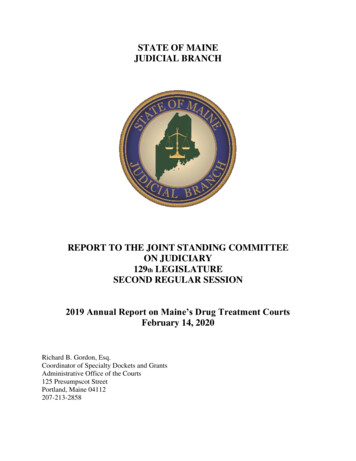
Transcription
STATE OF MAINEJUDICIAL BRANCHREPORT TO THE JOINT STANDING COMMITTEEON JUDICIARY129th LEGISLATURESECOND REGULAR SESSION2019 Annual Report on Maine’s Drug Treatment CourtsFebruary 14, 2020Richard B. Gordon, Esq.Coordinator of Specialty Dockets and GrantsAdministrative Office of the Courts125 Presumpscot StreetPortland, Maine 04112207-213-2858
Table of ContentsI. Executive Summary . 3II. Overview of Maine’s Treatment Courts. 4II. Adult Drug Treatment Courts . 8A.What are Adult Drug Treatment Courts? .8B. Program and Structure of the Adult Drug Treatment Courts, Co-Occurring Disorders Court,Veterans Treatment Court, and Veterans Treatment Track . 10C.Substance Use Disorder Treatment and Case Management Services . 12D. Funding and Resources for Adult Drug Treatment Courts, Co-Occurring Disorders Court,Veterans Treatment Court, and Veterans Treatment Track . 13E.Data, Evaluation, and Substance Use Trends . 14F.Collaboration . 18G.Training and Education. 19H.Future of Maine’s Adult Drug Treatment Courts. 21III. Family Recovery Courts . 21A.What are Family Recovery Courts? . 21B.Program and Structure of the Family Recovery Courts. 22C.Substance Use Disorder Treatment and Case Management Services . 23D.Funding and Resources for Family Recovery Courts . 24E.Data and Evaluation for Family Recovery Courts . 24F.Collaboration . 25G.Training and Education. 25H.Future of Maine’s Family Recovery Courts . 26IV. Summary . 26Appendix A . 272
I. Executive SummaryPursuant to the provisions of 4 M.R.S. §423, the Maine Judicial Branch submits to the JointStanding Committee on the Judiciary this annual report on the establishment and operation ofsubstance use disorder treatment programs in the courts. The current types of treatment programsin Maine’s courts are Adult Drug Treatment Courts (ADTC), Co-Occurring Disorders Court(CODC), Veterans Treatment Court (VTC), Veterans Treatment Track (VTT), and FamilyRecovery Courts (FRC). This is the eighteenth consecutive report provided to the Committee. Itdescribes the structure, processes, and outcomes associated with the operation of these dockets bythe Judicial Branch and its Executive Branch, county, and private partners. Additionally, itprovides statistics as to participation, recidivism rates, and challenges facing these courts.During the 2019 calendar year, there was a total of 295 active participants in the ADTCs,CODC, VTC, and VTT, an increase of 11.3% over the number of participants in the previous year,and the largest number of participants in any calendar year. There were 70 graduations from theprograms, an increase of 7.6% over the previous year. The total number of terminations declinedby 12.2%. There was a 97.2% increase in the number of pending referrals at the conclusion of the2019 calendar year. These numbers show that the criminal treatment courts in Maine areincreasing in capacity, effectiveness, and ability to work with a high-risk/high-need population.During the 2019 calendar year, ADTCs operated in six counties: Androscoggin,Cumberland, Hancock, Penobscot, Washington, and York. In addition to the six ADTC’s, thereis a CODC and a VTC in Kennebec County. Justice Nancy Mills established the VTT within theCumberland ADTC with the first veteran admitted to that program in January 2019. Each of thesenine criminal treatment courts and/or tracks has a maximum capacity of twenty-five (25)participants at a time that receive case management services.During the 2019 calendar year, there was a total of 68 active participants in the FRCs, anincrease of 23.6% from the previous year. There was a corresponding 12.5% increase ingraduations. There was also a 23% increase in terminations. FRCs are civil courts and lack thesame enforcement and sanction capabilities of the ADTCs. The civil nature of the FRCs partiallyaccounts for the increased terminations, as the FRCs do not have the same sanctioning ability asthe ADTCs. While there has been an increase in referrals to the FRCs, they consistently remainunder capacity. The FRCs have a capacity of 75 participants. On December 31, 2019 there wereonly 31 participants. Low participant and referral numbers are a recurring issue that appear to bepartly based on high turnover rates of both OCFS case workers and FRC case managers.During the 2019 calendar year, FRCs operated in three counties: Androscoggin, Kennebec,and Penobscot. Each of these three civil treatment courts has a maximum capacity of twenty-five(25) participants at a time that receive case management services.1Enrollment numbers are established by the contracts between DHHS and the various treatment providers. Mosttreatment providers subcontract the case management services to Maine Pretrial Services. Several courts operate ator slightly over the maximum as case management services are not as intensive during the later phases of participationin a treatment court.13
II. Overview of Maine’s Treatment CourtsTreatment courts that operate with fidelity to evidence-based best practices are proven tobe an effective response for high-risk/high-need individuals who are struggling with substance usedisorder2 that are in the court system. This includes criminal defendants and parents in jeopardyof losing their children.The ADTCs, CODC, VTC, and VTT provide rigorous accountability for the participantswho have either pled guilty or have been found guilty of serious crimes. The underlying crimethat brought the participant into the criminal justice system must be drug and/or alcohol related,either as an element of the offense or as the underlying contributing factor to the commission ofthe offense.Participation in the criminal treatment courts is voluntary and provides defendants, orprobationers, with a demanding, community-based alternative to lengthy terms of incarceration.Unlike some drug courts in other states that operate on a deferral-from-prosecution model for lowlevel offenders, Maine’s drug treatment courts target high-risk/high-need individuals and requirethe defendant to enter a plea of guilty to the serious criminal charge(s) pending against him or her.Upon successful completion of the treatment court program, the sentence imposed is typicallysubstantially less severe than the sentence normally imposed for similar charges.Prior to admission to a criminal treatment court, an extensive evaluation of each applicantis conducted in order to ensure the applicant meets the objective eligibility criteria for admission.The evaluation includes the following steps: Referral to the treatment court by counsel, probation officer, community member,court, or defendant.Defendant is interviewed and authorizes waivers for gathering of medicalinformation.In-person interview of defendant by case manager and treatment provider todetermine a level of care.Independent verification of the information gathered in the interview.Risk assessment completed using a qualified screener (LSI-R or LSI-SV)3.Carey, S.M. et al, (2012). What Works? The Ten Key Components of Drug Court: Research-Based Best Practices.Drug Court Review, 8(1), 6-42. Marlowe, Douglas B., (2011). The Verdict on Drug Courts and Other ProblemSolving Courts. Chapman Journal of Criminal Justice, 2(1), 57-96. Shaffer, Deborah K., (2011). Looking Inside theBlack Box of Drug Courts: A Meta-Analytic Review. Justice Quarterly, 28(3), 493-521. National Institute of ts/Pages/work.aspx, citing Finigan et al (2007) Impact of a Mature DrugCourt Over 10 Years of Operation: Recidivism and Costs.2The Level of Service Inventory – Revised (LSI-R) is used to assess the level of risk for recidivism of an offenderand has been used by MDOC since 2004. The LSI-R score is comprised of 10 categories or domains: CriminalHistory, Education/Employment, Finances, Family/Marital, Accommodations, Leisure/Recreation, Companions,Alcohol/Drug, Emotional/Personal, and Attitude/Orientation. The total LSI-R score can range from 0 to 54, with thelower numbers indicating less likelihood of recidivating. The predictive validity of the LSI-R has been demonstratedwithin several different correctional settings (Andrews, 1982; Andrews & Robinson, 1984; Bonta & Andrews, 1993;Bonta & Motiuk, 1985; Gendreau, Goggin, & Smith, 2002), and has predictive validity for various sub-groups of theoffender population, such as female offenders and African-American offenders (Coulson, Ilacqua, Nutbrown,34
Review of demographic information (jail file) by case manager.Document review of defendant’s court paperwork by assigned prosecutor anddefense attorney.Records request and review for substance use disorder diagnosis and priortreatment history.Records request and review for mental health diagnosis and prior treatment history.Coordination with defense counsel, prosecutor, and probation officer (if onprobation).Creation, review, and execution of informed releases of information.Needs assessments completed using qualified screening tools covering substanceuse disorders, mental health issues, and trauma screenings (AC-OK4, TCU DrugScreen 5 with Opiate Supplement5, and Mental Health Screening III 6).Report on screening and level of care evaluation to the treatment court team.Once admitted to a criminal treatment court, participants are required to meet with thepresiding judge weekly or bi-weekly (depending upon the frequency of court sessions) to reporton and account for their progress. Participants are also required to maintain regular weekly (ormore often) contact with their case manager and, if on probation, their probation officer. Inaddition to frequent court appearances, the participant must: actively seek and/or maintain paidemployment, attend educational programs, or engage in community service; pay all fines,restitution, child support, and taxes; maintain sober and stable housing; undergo frequent andrandom observed drug testing (a minimum of twice per week) for the presence of alcohol and/orother drugs; and participate satisfactorily in intensive treatment and self-help groups. Failure toabide by these conditions can result in the imposition of sanctions by the Court, up to and includingGiulekas, & Cudjoe, 1996; Lowenkamp, Holsinger, & Latessa, 2001; Lowenkamp & Latessa 2002). Many LSI-Rdomains address dynamic (can be changed) risk factors and are important for case planning and case management, asprobation officers and treatment providers work with a probationer to effect positive behavior changes. Others, suchas Criminal History, are static and cannot be changed. Quoted from, Rubin, Maine Adult Recidivism Report (2013)at pages 1 and 6.4 The AC-OK Screen for Co-Occurring Disorders (Mental Health, Trauma Related Mental Health Issues & SubstanceDisorders) was designed to determine if a person who asks for help from either a mental health agency or a substancedisorder treatment agency needs to be assessed for the possible co-occurring disorder of Mental Health, TraumaRelated Mental Health Issues, and Substance Disorders. All agencies who are Maine Care contracted providers,including private practitioners, are required to screen. Also included are any programs having contracts with theOffice of Child and Family Services. k.shtml (last visited Jan.28, 2020).5 The TCU Drug Screen 5: Opioid Screening Tool. This is a new self-report screening tool from Texas ChristianUniversity (TCU) is available to help justice and health professionals quickly gather detailed information about opioiduse, allowing for more rapid referral to treatment services when appropriate. It also collects important informationabout the potential risk of opioid drug overdose. Developed by researchers at the Institute of Behavioral Research atTCU, along with the Center for Health and Justice at the Treatment Alternatives for Safe Communities, the TCU DrugScreen 5-Opioid Supplement can help determine earlier in the screening process if there is an immediate need forservices to address opioid use problems.Justice Center, The Council of State -abuse/publications/tcu-drug-screen-5/ (last visited Jan. 28, 2020).6 The Mental Health Screening Form-III (MHSF-III) was initially designed as a rough screening device for clientsseeking admission to substance abuse treatment programs.Iowa Department of Public anceAbuse/jackson mentalhealth screeningtool.pdf (last visited Jan. 28,2020).5
short term incarceration. Multiple, serious repeat violations, serious new criminal conduct, orfailure to make progress toward attainable goals can result in sanctions, including termination fromthe program.Specialized treatment provided through contracts between the Maine Department of Healthand Human Services (DHHS) and local behavioral healthcare agencies support recovery fromsubstance use disorder, address criminogenic thinking, provide parenting education, assist with thedevelopment of more pro-social behaviors, and address mental health and trauma related issues.Additionally, the case manager for each program provides direct and frequent supervision ofparticipants. This supervision includes random alcohol and/or other drug testing (at least twiceper week), assistance in developing individualized plans of action to achieve and maintain sobriety,guidance in refraining from criminal behavior, assistance in securing sober and stable housing, andother goals. Case management services are provided by the treatment agency contracted with eachcourt.7During the 2019 calendar year, there was a total of 295 active participants in an ADTC,CODC, VTC, or VTT. This is an increase of 30 participants, representing an 11.3% increase from2018, and continuing the trend of increased participation since Change from2018GRADUATED 1631124157264525911422136304128945295182704371 30 11.3% 10 5.8% 5 7.6%-6-12.2% 35 97.2%Case management and treatment service contracts are administered by the Office of Substance Abuse and MentalHealth Services with the Maine Department of Health and Human Services.76
ADTCs generate measurable cost avoidance to the criminal justice system through reducedrecidivism and reduced incarceration.8 ADTC services also result in reduced health care coststhrough participant recovery from substance use disorder. Conservatively estimated, for every 1.00 spent in the ADTCs in Maine, approximately 1.87 is generated in savings to the state’scriminal justice system. 9 National research on a mature drug court (more than ten years inoperation) has concluded that when all costs are compiled, including those to potential futurevictims, the average savings over a five-year period from the initial hearing are 12,218.00 perdrug court participant.10A vital measure of a drug treatment court’s operation is the recidivism of its participantscompared to traditionally adjudicated defendants. Maine’s dockets have continued to showsignificant reductions in re-arrest compared to traditionally adjudicated defendants. In the mostrecent independent evaluation, conducted by Hornby Zeller Associates (2016), it was determinedthat the recidivism rate (defined as a new criminal conviction within 18 months of admission) fordrug court graduates was 16%. This compares to a recidivism rate of 32% for individuals whoapplied but were not admitted, and recidivism rate of 49% for those admitted and later expelledfrom a treatment court.11 In comparison, according to a 2013 Maine Department of Correctionsstudy, their most recent recidivism rate (defined as a new arrest within 12 months) for personswhose LSI-R score was in the moderate to high-risk category (similar to persons served by theMaine Treatment Courts) was between 28.2% and 47.1%.12In late 2019, Maine Pretrial Services received funding from the Maine Substance Abuseand Mental Health Services Department of Maine’s DHHS for a new independent evaluation ofthe criminal treatment courts. This evaluation will be completed by the Public Consulting Group,headed by Helaine Hornby, formerly of Hornby Zeller Associates. It is anticipated that thisevaluation will be completed in the fall of 2020.The Family Recovery Courts provide treatment and case management services forparticipants that have an open child protective case and are in jeopardy of having their child(ren)removed or their parental rights terminated due to an underlying substance use disorder. TheFRC’s in Maine provide rigorous accountability for their participants as they work towardreunification in the Child Protective action.Participation in an FRC court is voluntary and provides parents with additional communitybased services in addition to the mandated treatment services required to alleviate jeopardy. Whilethere is no guarantee that reunification will take place as a result of the successful completion ofthe FRC, Children and Family Futures, the national organization tasked with training familyRossman, S.B. et al, (2011) The Multi-Site Adult Drug Court Evaluation: The Impact of Drug Courts Volume 4.Retrieved from Urban Institute, Justice Policy Center -Court-EvaluationThe-Impact-of-Drug-Courts.PDF (last visited Jan. 29, 2020)9 Hornby Zeller Associates (2013) An Evaluation of Maine’s Adult Drug Treatment Courts.10 National Institute of Justice. /work.aspx, citing Finigan et al(2007) Impact of a Mature Drug Court Over 10 Years of Operation: Recidivism and Costs. (last visited Jan. 29,2020)11 Hornby Zeller Associates (2016) Maine’s Drug Treatment Courts, Final Evaluation Report 2011-2015.12 Rubin, 2013 Maine Adult Recidivism Report, at page 6.87
treatment drug courts, reports that 50% of families who participate in a family treatment drug courtachieve reunification. 13During the 2019 calendar year, there was a total of 68 active participants in an FRC. Thisis an increase of 13 participants, representing a 23.6% increase from tFRCTotal2310352123135325228185156831916926 13 23.6% 6 24% 1 12.5% 3 23%-1-10% 15 136%Change2018fromThe documented benefits of an FRC include a greater likelihood to enter into andsubsequently complete treatment, more frequent and negative drug tests, and once the child(ren)return to the home there is less likelihood of subsequent removal. Children of FRC participantsspend less time in foster care. 14,15 Other benefits include improved parenting skills, improvedaccess to basic needs, a decrease in reported serious domestic violence incidents, an improvedcommunity support network, and identification of mental health issues with referral for services.16II. Adult Drug Treatment CourtsA. What are Adult Drug Treatment Courts?Adult Drug Treatment Courts (ADTC) are a type of specialty docket known as a problemsolving court. They are defined as follows:[A] specially designed court calendar or docket with the purpose of reducingrecidivism and SUD’s among substance-using offenders and increase thelikelihood of successful habilitation through early, continuous, and intensejudicially supervised treatment, mandatory periodic drug testing, and use ofappropriate sanctions and other habilitation services.17Children and Family Futures, / (last visited Jan. 29, 2020)Hornby Zeller, Inc., Evaluation of Maine’s Family Treatment Drug Courts, A Preliminary Analysis of Short andLong-term Outcomes, Hornby Zeller Associates, Inc., January 2007.15 Hornby Zeller, Inc., Evaluation of the Lewiston Family Treatment Drug Court, A Process and IntermediateOutcome Evaluation, Hornby Zeller Associates, Inc., December 2007.16 Hornby Zeller, Inc., Bangor Family Treatment Drug Court, A Process and Outcome Evaluation, Hornby ZellerAssociates, Inc., May 201417 Substance Abuse and Mental Health Services Administration, i-19-002. (Last visited Feb 3, 2020)13148
ADTCs result in an increase in personal, familial, and societal accountability on the part ofthe participants, the development of pro-social attitudes and behaviors, and the promotion ofhealthy and safe family relationships. ADTCs reduce unnecessary incarceration by promotingmore effective collaboration and efficient use of resources among the courts, criminal justicepartners, and community agencies.Maine’s initial six ADTCs were created in August 2000 and began accepting participantsin April 2001.18 These courts were located in Androscoggin, Cumberland, Oxford, Penobscot,Washington, and York counties. The Oxford County ADTC was discontinued due to low censusin May 2004. The original Penobscot County ADTC graduated its final participant in 2012. Anew Penobscot County ADTC opened in the fall of 2016 following extensive planning,organization, and development by a dedicated group of community mental and physical healthspecialists, local Legislators, the City of Bangor Department of Health, Penobscot County lawenforcement, defense counsel, court personnel, the Department of Corrections, Maine PretrialServices, and the Penobscot County District Attorney’s Office. 19 In January 2019, under thedirection of Justice Nancy Mills, Cumberland County initiated a Veterans Treatment Track (VTT)within the Cumberland ADTC.Currently, Maine operates ADTCs in Androscoggin, Cumberland, Hancock, Penobscot,Washington, and York counties. These courts generally limit participation to residents of thecounty where the treatment court is located or the county where the crime occurred. There isinterest in expanding the treatment courts in Maine, with the greatest need and support for anADTC in the midcoast region.In addition to the ADTCs, Maine has other specialty court dockets that are problem-solvingcourts. In 2005, Justice Nancy Mills initiated a Co-Occurring Disorders Court (CODC) inKennebec County. The CODC was created to address the needs of participants that are involvedin the criminal justice system due to a severe and persistent mental health disorder in addition to asubstance use disorder. While located in Kennebec County, the CODC accepts cases from acrossthe State of Maine.In 2011, Justice Nancy Mills initiated a Veterans Treatment Court (VTC) in KennebecCounty. The VTC was created to address the needs of veterans who become involved in thecriminal justice system based on a substance use disorder and/or mental health disorder. Whilelocated in Kennebec County, the VTC accepts cases from across the State of Maine. This docketincludes a team member from the United States Department of Veterans Affairs (VA), known asa Veterans Justice Outreach officer (VJO) who coordinates treatment services with Togus VAHospital and access to other community benefits.An Additional Adult Drug Treatment Court in Hancock County joined the state system following the provision offunding by the 123rd Legislature on July 1, 2008, after being established as a county deferred-sentencing project in2005.19 On January 16, 2016, the Supreme Judicial Court issued Administrative Order JB-16-1, Establishment andOperation of Specialty Dockets, which specifies the requirements for the establishment, content requirements, andoperations of all specialty dockets in Maine. This includes Adult Drug Treatment Courts.189
In 2019, the Cumberland County ADTC initiated a Veterans Treatment Track (VTT),admitting seven veterans in its first year of operation. It is anticipated that the enrollment in theCumberland VTT will be sufficient in the future for it to be designated as a stand-alone VTC. InOctober 2019, the Maine Department of Health and Human Services (DHHS), Office of SubstanceAbuse and Mental Health Services (SAMHS) supplemented the budget for Central Maine FamilyCounseling (dba Blue Willow) and Maine Pretrial Services, to facilitate expansion of theCumberland VTT and implementation of VTTs in other operating ADTC’s. These specialtydockets were developed along the lines of the drug court model and operate under similarprocesses.B. Program and Structure of the Adult Drug Treatment Courts, Co-OccurringDisorders Court, Veterans Treatment Court, and Veterans Treatment TrackThe location, type of docket, presiding judicial officer, treatment agency, and casemanagement provider for the active criminal problem-solving courts in Maine in 2019 aresummarized below:COUNTYTYPEOFCOURTAndroscoggin ADTCPRESIDINGJUDICIAL OFFICERTREATMENTAGENCYHon. John MartinCatholic CharitiesBlue Willow*CumberlandADTCCumberlandVTTHancockADTCHon. MaryGayKennedyHon. MaryGayKennedyHon. Patrick LarsonKennebecCODCHon. Matthew TiceAroostook MentalHealth ServicesBlue WillowKennebecVTCHon. Matthew TiceBlue WillowPenobscotADTCHon. Charles BuddWellspring, Inc.WashingtonADTCHon. David MitchellYorkADTCHon. Wayne DouglasAroostook MentalHealth ServicesBlue WillowBlue WillowCASEMANAGEMENTSERVICESCatholic CharitiesMaine PretrialServicesMaine PretrialServicesMaine PretrialServicesMaine PretrialServicesMaine PretrialServicesMaine PretrialServicesMaine PretrialServicesMaine PretrialServices*Central Maine Family Counseling operates as Blue Willow.Judge John Romei completed his service as the judge of the Hancock County ADTC inOctober 2019 and Justice Nancy Mills retired in December 2019. As a result, there were severalchanges in the judicial assignments within the treatment courts. In Cumberland County, JusticeMaryGay Kennedy replaced Justice Nancy Mills as the presiding judicial officer in the ADTC andthe VTT. In Androscoggin County, Judge John Martin replaced Justice MaryGay Kennedy as thepresiding judicial officer in the ADTC. In Kennebec County, Judge Matthew Tice replaced Justice10
Nancy Mills as the presiding judicial officer in the CODC and the VTC. In Hancock County,Judge Patrick Larson replaced Judge John Romei as the presiding judicial officer in the ADTC.Each of these courts generally serves the population that resides in that particular countywith the exception of the CODC and the VTC in Kennebec County. Participants from across theState of Maine are eligible to be referred to the CODC or the VTC. A CODC or VTC participantfrom outside Kennebec County would need to relocate to Kennebec County or have adequate andreliable transportation to appear for all required court sessions, mandated treatment, and casemanagement appointments.Justice Nancy Mills 20 oversaw the administrative duties for the treatment courts as theChair of the Adult Drug Treatment Court Steering Committee until October 2019. Judge DavidMitchell, who presides over the Washington County ADTC, now chairs the ADTC SteeringCommittee and is responsible for administrative oversight of the treatment courts. The ADTCSteering Committee meets on a quarterly basis (January, April, July, and October) in eitherAugusta or Bangor and is responsible for ensuring that the treatment courts adhere to best practicesand national standards. The ADTC Steering Committee is composed of the treatment court judges,representatives from the Administrative Office of the Courts, the District Attorneys, defensecounsel, Office of the Maine Attorney General, Department of Corrections Probation Division, theMaine Co-Occurring Collaborative, Maine DHHS, treatment agencies, case managementproviders, and a community representative. See Appendix A for a membership list.The position of Coordinator of Specialty Dockets and Grants is held by Richard Gordon,Esq. Mr. Gordon previously held the position of Director of Problem-Solving Courts for the Officeof the Public Defender, 4th Judicial Circuit, Florida, where he oversaw three adult drug treatmentcourts, one juvenile drug treatment court, two mental health courts, and three veterans treatmentcourts. The position of Coordinator of Specialty Dockets and Grants is overseen by Anne Jordan,Esq., Manager of Criminal Proces
3 I. Executive Summary Pursuant to the provisions of 4 M.R.S. §423, the Maine Judicial Branch submits to the Joint Standing Committee on the Judiciary this annual report on the establishment and operation of
